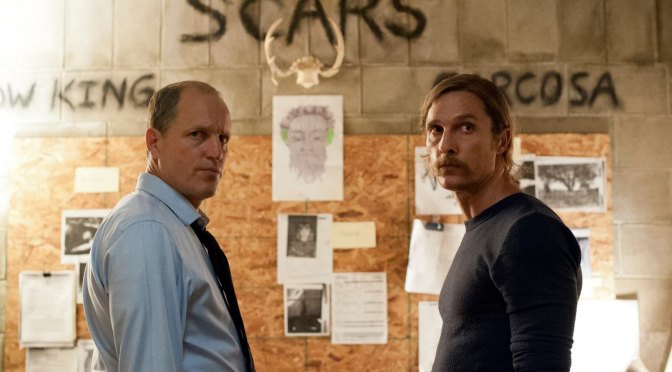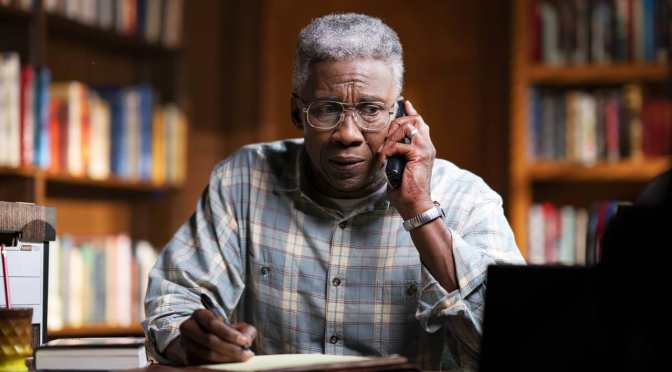
This sixth episode of True Detective is titled Hunters In The Dark and that’s largely how it feels as we enter this final third of the season – as viewers, we still have a lot to learn. The myriad strands of the case are slowly coalescing but we are no wiser to the fate of Julie Purcell as the mystery around her disappearance continues to unfold and deepen further. This season might have primarily been focused on the efforts of Hays and West as the detective duo unpick the minutiae of this grim conspiracy, but there are other hunters in this pack – the amateur sleuth Amelia, the dirt digger Elisa, the vigilante Tom – as well as those shadowy figures stalking the case from the periphery, known but unknown and imbuing the narrative with a sickly sense of impending dread.
1980
The case is all but concluded on this timeline. Hays is determined to explore the evidence further after the fateful aftermath of the Woodard massacre, but Kindt is adamant they have their man – and they will convict him in absentia for the murders of the Purcell children, with the police assuming Brent burnt Julie’s body in his porch-side oil drum. Hays is presented with the evidence of Will’s backpack and Julie’s shorts as a concrete indictment against the man, but these items raise more questions than answers for the detective – he’s sure there is more to this case.
Undeterred, Kindt hosts a press conference to advise that the case is closed – with both Lucy and Tom leaving separately during proceedings after the latter attempts a lacklustre reconciliation through a tentative handclasp. Amelia follows Lucy to the car park to deter a reporter from intruding on her grief, but she isn’t in a forgiving mood with the teacher and drives off into the night – the last time we see her alive in this timeline.
1990
In the most active timeline this week, the recording of Julie denouncing Tom means he has instantly become their top suspect. Hays and West are rousted by Kindt for not having investigated Tom’s original alibi properly and pushes the pair to interrogate him robustly. West is quietly furious with Tom for betraying his faith in him as a good person, but Hays turns the heat up further by questioning Purcell’s paternity around Julie. “Some question that she was yours?” he raises, but Tom is outraged – “That child is mine!” he screams before collapsing into hysterical screaming.
Kindt is hungry for an immediate indictment, but West presses for caution – arguing that they have no evidence against him. The only real information they uncover in their ensuing investigation is that Tom was going off the rails long before his children went missing – his burgeoning alcoholism perhaps related to his shame of being secretly homosexual, something which is inferred in his work colleagues having spotted him hanging out at a gay bar back in 1980 and a “conversion therapy” leaflet in his trailer in the current day. Hays puts forward a loose theory that Tom might have been caught cruising by his kids in the woods and killed them to keep his secret, subsequently planting the evidence at Woodard’s house – but West bats it away as implausible, perhaps consumed by his own guilt at not really knowing Tom as well as he thought.
The duo then turns their attention on Harris James, who was the officer that reported Will’s backpack being found at the scene. It’s revealed that James left the force in 1981, the year after the Purcell case – to take a well-paid job as Chief Security Officer at none other than Hoyt Foods. Such a heavyweight coincidence has Hays and West dig into his employer’s requirements for the role – it’s a big pay-cheque to be guarding a chicken recipe, Hays argues. James drops them his contract’s statement around this which is ominously open to a deadly interpretation, before throwing in a misplaced compliment about Hays’s body, which definitely lingers in the air after as being strangely formulated.
The plot thickens considerably this episode when Dan O’Brien resurfaces, looking exponentially rougher than when we last saw him in 1980, and demanding $7000 to give Hays and West information about Julie Purcell. Despite the detectives’ strong arm tactics, O’Brien is clearly more scared of whoever else is out there with involvement in the case, saying they are the kind of “people who don’t renegotiate”. He infers ‘they’ are responsible for Lucy’s death, who it is revealed grew up with Dan as a child when her mother died prematurely. West tells him it will take a few days to put together the cash, but Dan is adamant Julie doesn’t have that long – “those motherfuckers have a head start on y’all” he predicts, ominously.
Meanwhile, Amelia is on her own investigate path, having told Hays her publisher is keen for a sequel to her original book, wanting it based around the new investigation. She tracks down a friend of Julie’s at a local convent that helps street kids, who tells her the girl used many names but mainly Mary July, “as in summertime”. Increasingly, the inference around the month in her name seems to indicate something bigger – perhaps a way of cataloguing the girls stolen by our anonymous villain? Julie’s friend alludes to the same place as the vagrant in the last episode, except this time Julie referred to herself as a “queen in the Pink Castle” – a recurring theme with deeply portentous implications.
Amelia pulls double duty this week on coaxing out important clues. Hays often accuses his wife throughout the show – and by extension, the viewer – of being a voyeur in the misery of others. The girl at the convent implores her to instead “write about what happens out here, what happens to girls”, and there is a sense her chosen career path isn’t a popular one. At a local bookstore reading, she is confronted by a black man with a dead-eye who aggressively accuses her of “makin’ your money and milkin’ their pain” before storming out – but Amelia is already making connections about his distinctive appearance to a long forgotten clue, trailing off with the word “Dolls….”. Is the writer about to put herself in more danger than she can handle?
Tom develops his own brand of investigation in this episode too, after being released on bail and over-hearing detectives talk incredulously about the reappearance of Dan O’Brien and his demands. Knowing him better than the law does, he tracks down the junkie to his old scoring patch at a run-down local motel. Bracing Dan at gunpoint and beating him into submission, he tells Tom that Lucy was paid off by somebody for what happened back in 1980, and the name of that person was what he was selling to the cops.
We aren’t privy to the name in that bruising encounter, but it’s no surprise when we see Tom drive past Hoyt’s estate before breaking into his gargantuan home. In a cleverly edited sequence filmed largely through CCTV imagery, we see Tom guided into the bowels of Hoyt’s mansion by unseen people watching him on monitors. A series of thick steel doors have been left open for him, teasing the distraught man further into the complex before happening on a room – a pink room – that looks like a child’s play space. He looks off at something beyond our eye-line and stutters “Julie…?” as Harris James looms into view behind him.
2015
There’s scant activity in the most current timeline this week. Elisa presses Hays on the veracity of the original indictment, and again reiterates how unusually high the body count is in this case. The documentary maker pushes this further, inferring Harris James’s disappearance back in 1990 was not a coincidence – “I wonder if one day they’ll drag a quarry and find him?” she pontificates, causing Hays to nervously wrap up the interview.
Henry remonstrates with Elisa, and afterwards Hays broaches the affair his son is clearly having with her. Henry has no intention of leaving his wife, but says things have changed between them. “Nothing stays like it used to be” Hays offers, before venturing further in a telling statement, “Before I knew you I wasn’t a fearful man. I’ve been terrified since the day you was born. You can’t hold back anything – you can’t be stingy with the people you love”. It’s a moving elegy more to Amelia than it is marital advice to his son, but it makes you wonder what secret sacrifice Hays has made in the past to elicit such a response.
It’s this idea of suppressed memory that is stuck in the throat of the story, informing our relationship as a viewer with Hays, whose narrative is becoming increasingly hard to gauge as we progress. With the story rapidly running out of road as episodes fly by, it feels like the case will be concluded in a very final – and fatal – way back in 1990 and we as an audience will be exposed to the logistics of that through the shattered memory of Hays in the present day, with West as his guide. Armed with a gun and a smattering of key addresses – Hoyt’s house, Harris James’s widow, a former domestic help – it feels like these distant echoes from the past are building up to a deadly cacophony in the present.
Andy D
FOR OUR EPISODES ONE AND TWO REVIEW CLICK HERE
FOR OUR EPISODE THREE REVIEW CLICK HERE
FOR OUR EPISODE FOUR REVIEW CLICK HERE
FOR OUR EPISODE FIVE REVIEW CLICK HERE











